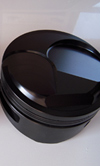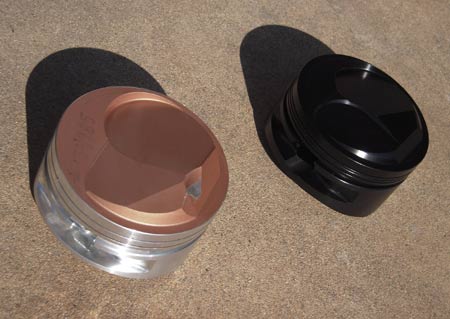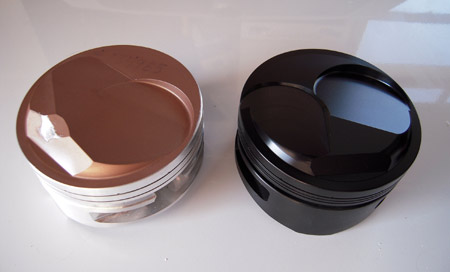Skirt wear on drag boat pistons
 Wayne Gaskamp, of Long Beach, California, builds drag boat engines for driver Mike DeClark's National Jet Boat Association (NJBA) boat, F Bomb, which set the records of 7.15 s Elapsed Time at 144.46 mph on the water at Bakersfield, California, in April 2011.
Wayne Gaskamp, of Long Beach, California, builds drag boat engines for driver Mike DeClark's National Jet Boat Association (NJBA) boat, F Bomb, which set the records of 7.15 s Elapsed Time at 144.46 mph on the water at Bakersfield, California, in April 2011.
The boat runs in two classes of this series, the seven-second class and the unblown fuel jet class. It's leading the latter in points after three events and is in second place in the former category.
The engine powering the boat is a 565 cu in V8 using a pair of four-barrel carburettors and running nitrous oxide. On the dynamometer it makes 1140 hp (without nitrous) and on the water with nitrous it's close to 1800 hp. "That's not a lot on the water," Gaskamp says. "There are fuel boats with a lot more, but for a carburetted motor it runs pretty good."
There are six to eight NJBA races every year and anywhere from 12-15 passes down a quarter-mile (1320 regulation) surface on any given weekend. The team for whom Gaskamp builds engines spends a lot of time testing the boat/engine combination to work on different tune-up scenarios.
"We have the [jet] pump that pushes the boat, and you have to get the impeller right with the rpms of the engine. You have to get enough water in the pump to make the boat move, and there are a lot of variables," Gaskamp says. "There are places with different water that changes the set-up a lot. We can overcome the water and air with nitrous because we're pumping our own air into the engine."

For all his race engines, Gaskamp chooses Venolia pistons (and con rods), doing business with Venolia as long as he's been building engines. Gaskamp uses a 628 g piston with a triple ring land, and finds the most wear on the skirts. "When the piston goes up it scuffs one side, and when it comes down it scuffs the other side. That's the most wear I see, other than the rings that go away real quick because of the nitrous," he says.
The service life on his pistons is customarily as few as 70 passes and as many as 140. "After 70 runs I take the rods off and see how they look. Sometimes we'll go two or three services before changing them out, but usually it's after 70 runs." That would amount to half a season of racing, he says. He installs aluminium rods for their longevity.
Gaskamp has been using the same piston spec for the past two years, and has specified his own dome shape. "I clay a dome for my application to fit the chamber of the head the way I like it. I like a lot of compression - that's what makes horsepower. I'm experimenting with different coatings at this point," he says.

Gaskamp is looking at a Teflon piston coating similar to that currently used in Top Fuel and Funny Car engines (which make close to 8000 hp) for his next batch. That Hardtuf black, hard-anodised coating is similar to that on his back-up piston (shown here). Gaskamp also produced a piston with a ceramic thermal barrier coating on the dome that, Venolia says, increases dome life.
"The top ring always gives up first (on his race-spec pistons). The bottom doesn't wear and the second doesn't really, but boy, the top one really takes a beating," he says. "I know that's normal in most applications but with the nitrous, it really is hard wear. It's gas-ported on the side so it's pushing the ring out hard on the cylinder, and with all the heat the nitrous makes it just wears out that ring."
Gaskamp changed from an accumulator groove because he wanted more material for his first ring land. "I wanted to help the top ring. I wanted more meat here for the first ring so I don't burn it up so quickly - to get it away from the heat a little more - so we put in more material up top so it doesn't burn through."
Fig's. 1 & 2 - Two sample Venolia pistons, one with added material to the first ring land as well as ceramic dome coating; the other with the hard-anodised Hardtuf black coating, both as used by Wayne Gaskamp
Written by Anne Proffit